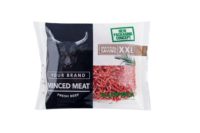Sustainable Packaging Solutions for Meat Packers

Running tube stock can eliminate the need for multiple sizes of costly premade bags, resulting in less rework and less waste. Courtesy TC Packaging.
Meat packers are feeling the pressures of rising production costs, alongside growing consumer demand for sustainability and responsible operations. This leaves cold chain manufacturers and meat packers trying to balance the complexities of the industry while meeting the demands of the marketplace.
Innovative technology can help boost operational efficiency and sustainable packaging options emerge as solutions that meet the needs of the modern marketplace.
Faced with added pressures of drought affecting the Midwest, reduced livestock herds and global economic impacts such as grain shortages, meat packers need to look at trimming operational costs wherever they can. The industry is focused on ensuring workplace safety and maintaining adequate staffing levels, which both have a crucial impact on operations.
In response to these challenging conditions, innovations include advanced packaging equipment that provides increased efficiencies, reduced waste and improved sustainability.
Companies can increase sustainability by pairing the right equipment with the right packaging materials. For example, TC offers a bag produced at its Tulsa, Oklahoma, plant using 38% less fossil fuel usage and generating 9% less greenhouse gas waste, compared to competitive products. An additional 10-15% price reduction per bag can be achieved when running tube stock versus premade bags, due to the elimination of the bagging process.
Running tube stock can eliminate the need for multiple sizes of costly premade bags, resulting in less rework and less waste. Additionally, corrugated waste is minimized by requiring fewer boxes. In addition, the right packaging can result in less spoilage and reduce food waste.
Sustainability is challenging as it relates to meat and protein packaging because some of the production methods required for food safety cannot be sacrificed in the pursuit of sustainability.
Sustainability is affected by factors like the packaging’s amount of recycled content or ease of recyclability, as well as how much energy or water was used in manufacturing processes. Manufacturers are increasingly prioritizing recyclable packaging and recycled content in packaging, along with light weighting and source reduction, and are looking to support packaging production processes offering a more responsible environmental footprint (i.e. using less water and energy) that will not affect shelf life.
Recent research by the Freedonia Group on food packaging in the U.S. found that meat and poultry packaging account for 16.9% of the market, with demand for food packaging products totaled $51.3 billion in 2022. Demand for protein packaging is forecast to increase 2.7% annually to $9.9 billion by 2027. Freedonia predicts one of the key drivers of sales will include the use of higher value packaging products to increase shelf life. However, the report cautions further gains may be restrained due to rising meat and poultry pricing, resulting in lower meat consumption.
Overall, as cold chain manufacturers look to grow in today’s economy, they appreciate equipment that is available, affordable, and reliable, while providing a sustainability advantage. The convergence of technology and sustainability have the potential to offer environmental and economic benefits simultaneously.
Looking for a reprint of this article?
From high-res PDFs to custom plaques, order your copy today!






